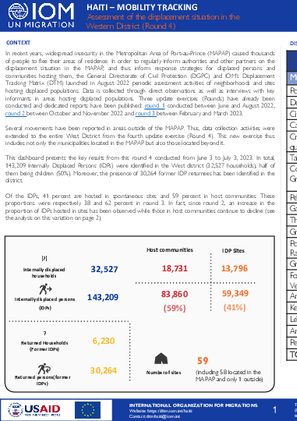-
Countries
-
Data and Analysis
-
Special Focus
-
Crisis Responses
Haiti — Factsheet on the displacement situation in West — Round 4 (03 June — 03 July 2023)

Contacter
DTM Haiti, DTMHaiti@iom.int
Langue
English
Emplacement
Haiti
Période couverte
Jun 03 2023
Jul 03 2023
Activité
- Mobility Tracking
- Site Assessment
- Baseline Assessment
- Village Assessment
In recent years, widespread insecurity in the Metropolitan Area of Port-au-Prince (MAPAP) caused thousands of people to flee their areas of residence. In order to regularly inform authorities and other partners on the displacement situation in the MAPAP, and thus inform response strategies for displaced persons and communities hosting them, the General Directorate of Civil Protection (DGPC) and IOM’s Displacement Tracking Matrix (DTM) launched in August 2022 periodic assessment activities of neighborhoods and sites hosting displaced populations. Data is collected through direct observations as well as interviews with key informants in areas hosting displaced populations. Three update exercises (Rounds) have already been conducted and dedicated reports have been published: round 1 conducted between June and August 2022, round 2 between October and November 2022 and round 3 between February and March 2023. Several movements have been reported in areas outside of the MAPAP. Thus, data collection activities were extended to the entire West District from the fourth update exercise (Round 4). This new exercise thus includes not only the municipalities located in the MAPAP but also those located beyond it. This dashboard presents the key results from this round 4 conducted from June 3 to July 3, 2023. In total, 143,209 Internally Displaced Persons (IDPs) were identified in the West district (32,527 households), half of them being children (50%). Moreover, the presence of 30,264 former IDP returnees has been identified in the district. Of the IDPs, 41 percent are hosted in spontaneous sites and 59 percent in host communities. These proportions were respectively 38 and 62 percent in round 3. In fact, since round 2, an increase in the proportion of IDPs hosted in sites has been observed while those in host communities continue to decline
